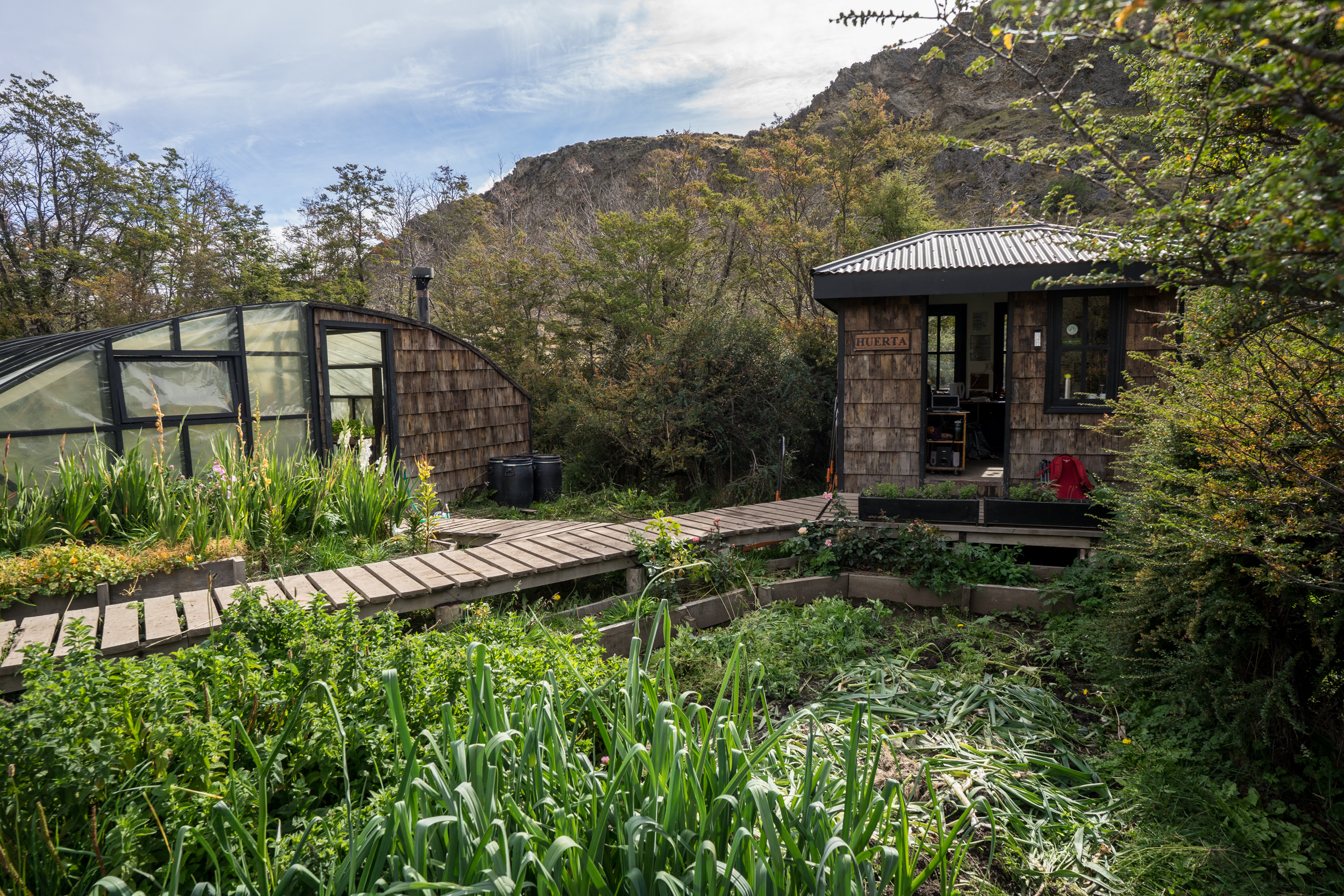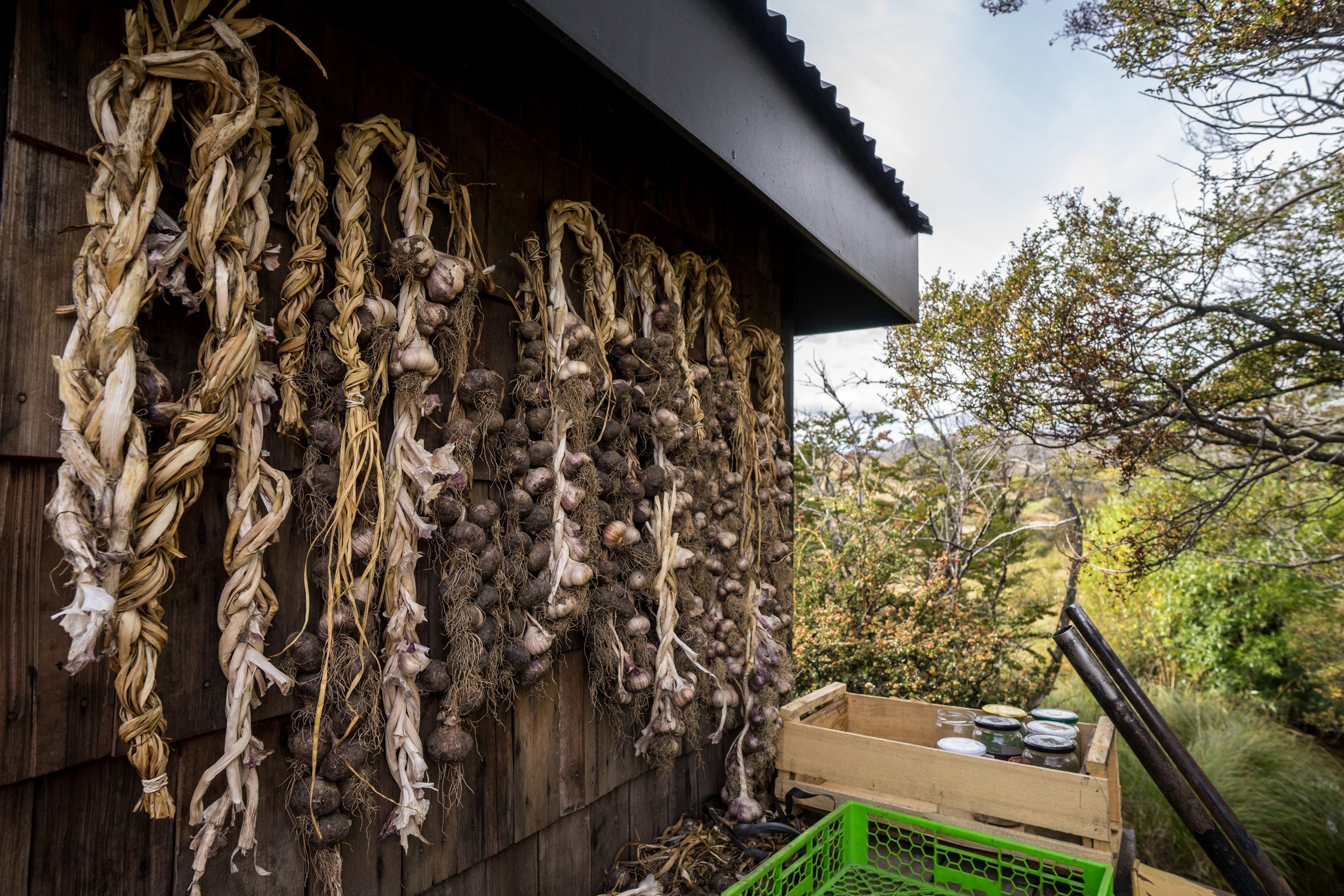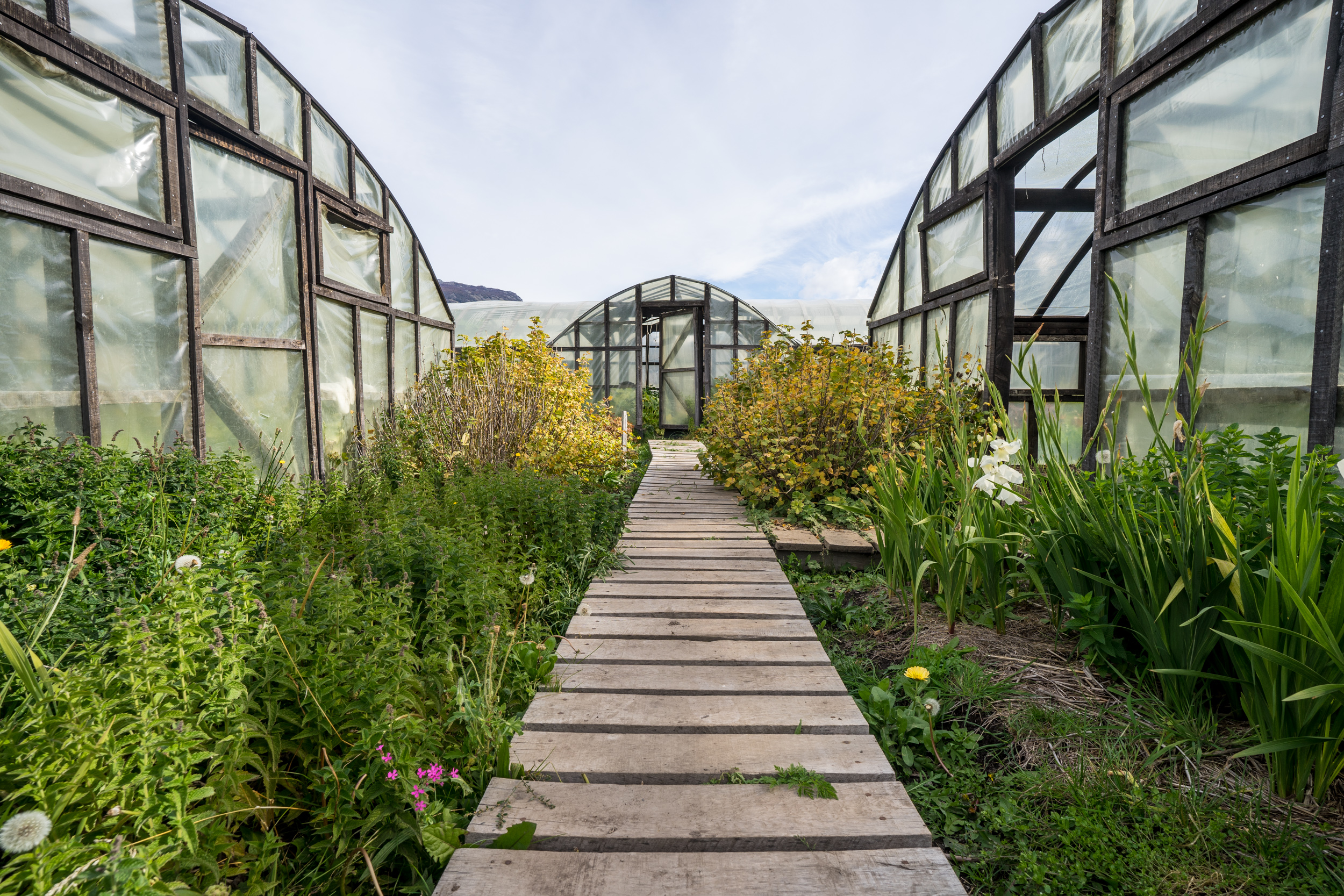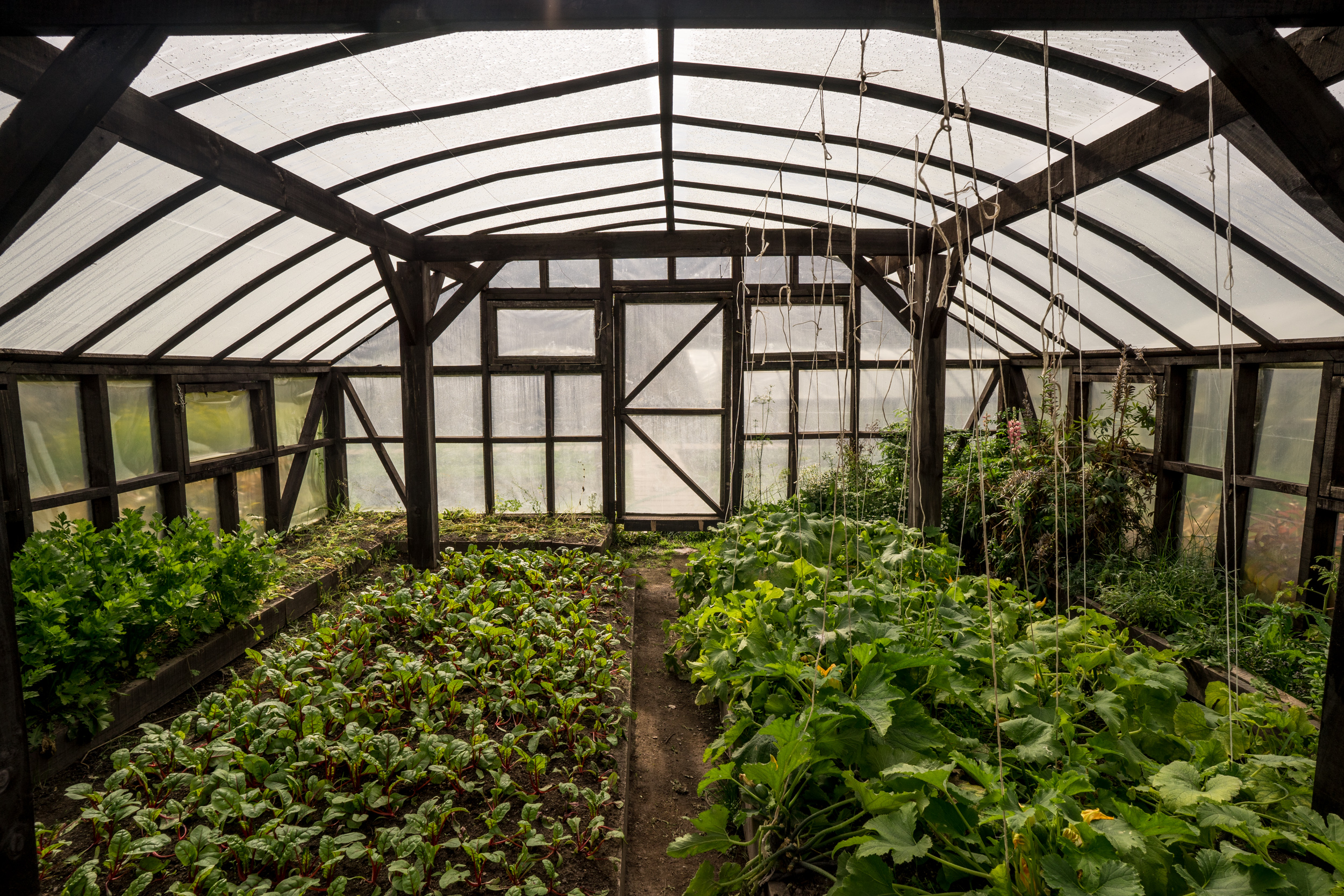THE CHOICES WE MAKE: The Vegetable Garden in Patagonia Park
Text & Photos: Andreea Lotak · 15 min read
Francisco’s bike stationed in front of the vegetable garden in Patagonia Park, Chile
“We shall not cease from exploration, and the end of all our exploring will be to arrive where we started and know the place for the first time.
”
The more we travel and learn about conservation projects, the more I discover things with which I am connected in ways of which I wasn’t aware before. Thinking about the direction I wanted to give to the interview we did with Francisco Vio, one of the two head gardeners in the Patagonia Park, the opening quote from above came to mind. I remembered the garden we had at the first house Justin and I rented when we moved to Charlottesville, Virginia three years ago. The owners of that place were incredible gardeners. At the time, though I was in awe of their work, maintaining what they had planted seemed like a pain. It was a task at which I failed because I didn’t put my heart in it. Now, with a lifestyle that keeps me mostly on the road, constantly aware of all the ways in which our choices impact the planet, I’ve built a strong connection with the idea of tending to a garden and growing my own food.
A few months ago, at the beginning of our journey, we accompanied our friends from the Pace Dub Van in one of their permaculture and sustainable living tours. We went to visit the household of an older couple outside of Punta Arenas, Chile. They had taken the path of organic farming, and what they had accomplished in a difficult terrain, with a harsh climate, was astonishing to me. It seemed like the most beautiful thing: to listen to their perspective on life, to understand their land ethic and the attitude toward the products growing from it, and to be in their loving presence. Then, three months later, I opened the gate to the vegetable garden in the Patagonia Park, in the Chacabuco Valley, and fell in love even more. This is a place where, on 600 sq m/6,450 sq ft, two masterminds of farming helped by a handful of volunteers manage to produce over three tons of food per season. It’s a place where function meets beauty, surrounded by peace. Getting to sit down here for an hour and have a talk with Francisco on a sunny afternoon was an invaluable lesson. Everything we learned is worthy of sharing “as is”, therefore I’ll take a step back and let him tell you the story of the vegetable garden in the Chacabuco Valley.
vegetable garden of the patagonia park
Planted on 600 sq metres/6,450 sq ft, this garden renders over three tons of produce per season.
"...to develop an agricultural method that is suitable for the region and in accordance with the culture that we are trying to create within the park: a culture of sustainability in the relationship between humans and nature"
Francisco: "Let’s start with the basics: the garden produces food. That’s our reason to exist: to produce food to supply the restaurant and the community of the park’s staff. We’ve accomplished the supply of needed goods twice a week for the restaurant. Plus, we’re giving baskets of veggies to the staff on the grounds. We have eight families here and six remote park rangers. It’s harder to reach the rangers, but we’re trying to send them at least one basket per week at the outposts.”
“The food production, which is an important mission, is fulfilled. The other mission, equally important, is to develop an agricultural method that is suitable for the region and in accordance with the culture that we are trying to create within the park: a culture of sustainability in the relationship between humans and nature. To do so it’s very important to collect data to understand if we’re on the right path. Plus, within the foundation and with every Tompkins project, beauty takes a very important place. So we have to comply with combining beauty with function. Maintaining a garden is a cost that many don’t understand, and we’re looking to be economically viable. That’s where the data collection is truly important. We can keep track of how many hours we work to produce a crop or to prepare the soil, how many hours to harvest, how many hours to plant seeds. All this data helps us keep the garden working efficiently. That’s what Javi does [Javier Soler is the other head gardener in the park]. Plus, we both do physical work, we’re both farmers. The volunteers help us a lot, too. In fact, this season I think they have been the main raw workforce. As we speak, volunteers are preparing the soil and are putting compost in the kale beds."
"The quality of the products is, therefore, incomparable. Every lettuce, every carrot grows at its full potential and the nutritional value is at its highest"
“The garden now has 1,200 square meters in total, but the planted area is only 600 square meters because the office and the boardwalks take up part of the space. We can call the method we’re using ‘bio-intensive’. Around the world there are many trends in agriculture. Although we’re not officially registered as ‘bio-intensive agriculture’, it’s basically what we’re doing. It’s a method focused not just on the organic, but also on regeneration. Regenerative methods are now more important than the simple organic ones. ‘Organic’ means that no chemicals, no poisons are being used. It doesn’t mean soil improvement, or ecosystem restoration, or that the community around the garden improves its way of life. With the method we use the whole ecosystem is doing better by being in the presence of this garden.”
“Basically, it is agriculture at a human scale, highly productive. In many cases, it doesn’t use any kind of fossil fuel tools. It’s based solely on manpower, the work is done by hand, artisanal, and it doesn’t take up large surfaces. Working on a small surface allows us to give much more attention to each individual crop. The quality of the products is, therefore, incomparable. Every lettuce, every carrot grows at its full potential and the nutritional value is at its highest. Plus, the harvesting process is generally a continuous one. We harvest twice or three times a week; the products are truly fresh. They don’t travel for a week, losing part of the nutritional value. You harvest it and you eat it. It’s the most awesome thing!"
"We also sit down with the chef to learn of what will be needed in the restaurant, and we review the data of the productivity of each bed to see where we need improvements"
“As far as crop diversity goes, we have over 25 species in the garden. We weigh every product harvested, every bed has a name, and the garden is divided by sectors. Before the start of each season we plan with a lot of attention what gets cultivated in every bed. Javi right now is working on planning the next season. By the end of April we’ll know what will be cultivated throughout the entire next season. We also sit down with the chef to learn of what will be needed in the restaurant, and we review the data of the productivity of each bed to see where we need improvements. So far this season we’ve rendered over three tons of food. It’s a very productive system. Plus, we produce mainly greens, leaves, so there’s a lot of quantity. We’re not currently producing a lot of roots with the exception of carrots, but we’re experimenting with potatoes and beets.
“For those two we have a small sector among the ñirre trees right outside, called the ‘chacra’. A ‘chacra’ in South America is an agricultural system that is much less intensive in regards to the attention that the crops need. Here in the garden it’s very common to grow lettuce, arugula, spinach. In the ‘chacra’ it’s more common to grow things like potatoes or beets. We’re experimenting with it. This year we worked there in a very non-intensive way, we invested little energy in it, and even like that we had a good harvest. Next year we want to work on it a bit more with the idea of satisfying better the needs that the restaurant has for such crops.”
Interrupted by a fox that stopped by to check out the garden, Francisco tells us a bit about some of the wild visitors:
“Foxes get into the compost bins, but thanks to them we don’t have any hares coming in. It’s full of hares around [the European hare is an introduced species to the region], but they’re scared of foxes. Some foxes come to sleep in the greenhouses because it’s warmer and they make a bed in the mulch. It’s natural. Something interesting happened to us with the guanacos, however (laughs). Last year we were fixing the fences. While they were down, we had planted rye for the summer [December - February]. Normally it’s cultivated in spring and harvested in the fall, so we planted it late, but the objective wasn’t to harvest it for food for that season, it was for soil enrichment. The guanacos came in March [fall in the southern hemisphere] and ate it all. They left it really short, like a lawn. We said ‘too bad, it’s all lost for compost. Let’s forget about it’. So we abandoned it, thinking that the crop would have to be replanted. It spent the winter frozen. For a reason we didn’t know at the time, instead of growing one stalk per root, each root had around five or seven stalks in spring. It reproduced prodigiously, and because of that it left no room for any weeds to grow. We harvested an incredible amount from it this season. It was stronger than we could have made it. After the incident we researched and found a video by Sepp Holzer, from Austria, who is one of the most famous representatives of the permaculture movement. He cultivates rye in the summer, let’s the cows eat it in the fall and then in the winter he lets it freeze. He harvests it the following year. So, he uses the same technique that we learned from the guanacos.”
“Generally, as a basic rule for an agriculture that follows best practices, the soil has to be built. The fertility is built. You don’t get anything from bringing fertile soil from elsewhere"
The conversation threads back to the soil and the productivity of the garden. We’re talking about compost and about how they’ve produced so much in a land that isn’t particularly productive:
“The restaurant and the staff households bring us compost weekly. We’ve worked to insert the idea in the culture of the restaurant, communicating what should and shouldn’t go in the compost and making sure that nothing bad gets mixed into it. We should look at compost more as a treasure than as garbage, which requires some patience and a certain infrastructure.”
“Generally, as a basic rule for an agriculture that follows best practices, the soil has to be built. The fertility is built. You don’t get anything from bringing fertile soil from elsewhere into your garden. Building our soil took a lot of work. Each bed’s soil was similar to what you see around us: dry, arid. There were some crops planted before we arrived, so we didn’t start really from zero in 2014, but the first two years we dedicated to preparing the beds. At first we did something called ‘double excavation’. With that you work the soil down to 60 cm [23 in]: the first 30 cm with a square shovel, the other with a pitchfork. This way we put plenty of air into the soil. We have close to 100 beds. Each bed required one full day of work to prepare. It’s really intense, like a day at a spinning gym. By introducing air into the soil when it’s not naturally very fertile, you allow for the roots to grow fast and reach deeper. You have a soil with very little fertility and by simply doing the double excavation it grows about 15 cm [6 in] higher due to all the air. We added a very large amount of compost. Working a small area, we can add plenty of compost every time we plant something.
"At this pace every year, the garden will produce more and more. When it reaches the point where it can’t produce more, the workload will be minimal”
“Beyond the typical crops for food, we always include in the crop rotation rye or fava beans. Their roots penetrate the soil. Rye, whose roots are like hairs, filters the soil, creating the channels through which carbon from the air is sucked in. This way the soil is enriched every year with such crops. Additionally, we sometimes get rock dust from the workers that work in the quarry and we mix it into the soil. Then I ask for pebbles and sand from the same construction people. So far they’ve brought us three truckloads of it and we mix it into the compost. Therefore, we have minerals, organic matter, microorganisms, and this way the soil increases in size, fattens and becomes more fertile. We’re already not doing the double excavation anymore, we simply air the soil for the structure to stay the same. Soil in nature is like this: leaves and branches fall to the ground and decompose with rain, so there is an organic layer; then there is an organic and mineral mix, and more in depth it’s much less organic and more mineral. Microorganisms and all the life that resides in the soil is mostly comprised in this first organic layer. If you twist it and turn it upside down you’ll make a mess. The bacteria and fungi from above will die, the first layer will be less fertile and so on. The double-excavation technique is good to start with, but later not anymore. At this pace every year, the garden will produce more and more. When it reaches the point where it can’t produce more, the workload will be minimal.”
"Pests are just a symptom of a lack of balance in the ecosystem. It means that we’ve created the conditions for one insect species to reproduce fast and become destructive"
Looking around I can’t help but notice how beautiful the place is beyond its functionality. There are all these colorful flowers surrounding the vegetable beds and the greenhouses. I ask why, assuming that it’s just because they’re pretty. And so I get the last piece of wisdom before Francisco has to head back to work:
“One of the principles of this type of agriculture that we’re doing is to seek the balance of the ecosystem. One of the things we have to be careful with in agriculture is pests. Pests are just a symptom of a lack of balance in the ecosystem, however. It means that we’ve created the conditions for one insect species to reproduce fast and become destructive. By having many types of flowers planted around the crops we’re looking at inviting a higher diversity of insects to come looking for nectar and pollen, including wasps. Wasps are predators of insects that become pests. There is a great diversity of wasps here. They spend a lot of time in the greenhouses, not allowing certain species to become established. We want to have flowers available for insects throughout the year. Since this is a conservation area, we have to handle it with a lot of responsibility to make sure we don’t introduce species that can become invasive. In the past we planted a few crops, and while working with an ecologist we were warned that they could spread and become invasive. We’re mainly planting flowers like the gladiolus, because their seeds don’t propagate with the wind. When they get ready to release seeds, we cut them. However, with every crop that we want to plant we have to investigate a lot beforehand.”
***
I leave inspired and with a deeper understanding of how the individual choices we make impact the land. For conservation, food production is a paramount issue. Done right, it’s also part of the solution that can restore some balance, both for our planet and in our lives.

















On a land destined to be logged, some of the most pristine valdivian temperate forests are now protected by this Nature Conservancy reserve. With its rugged coasts, ancient trees, impressive sand dunes, and local culture, it is a beautiful place to explore. Interview with Liliana Pezoa, administrator of the reserve.